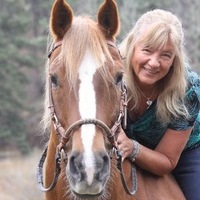
The Most Popular Horse Breeds Of 2019
Equestrian Advice & Guides General Equestrian
Build your business profile for FREE and expose your services to thousands of potential clients!
Create my profile now!
Each level we ride, no matter the discipline, the horse must partake by answering the question of collecting, and each time we collect the horse, we must use half-halts to tell him a change is coming. So what exactly is a half-halt?
Basically, it is a pause, a signal, a breath that warns and signals the horse of upcoming change. It is a combination of seat, leg and hands. Half-halt is energy focused in order to rebalance the horse for what is coming.
A half-halt is like the clutch of a vehicle that must be engaged before you can shift. Since most people no longer drive a manual transmission though, that analogy is lost on many. Another way to describe a half halt is to think of it as a half-forward, rather than a half-stop. If you want to change gears (speed, gait, direction) you don’t want to stop, but rather you want the horse to continue forward with intention. Yes, even to ride from a trot to a stop, you must have your horse going forward, with his body balanced and hind quarters engaged, before you can halt.
To understand both collection and half-halts, get down on your hands and knees and “walk” forward. Begin by letting your energy stay level or lower, then move your hands before moving your legs. Feel how your back lowers and sags? That’s a strung out, uncollected, heavy on the front end horse.
Next, start moving by first, “Collecting” and bringing your energy up. You’ll find that your shoulders and hips will engage and activate, and when you begin moving forward, your back will lift, your core will engage, and your knees will move first. This is what collection looks and feels like, and it allows you and your horse to move in sync.
Back to half-halts; if you visualize your horse and yourself as two separate balls of energy that need to be melded into one huge ball of energy, you’ll realize that in order to make that happen, you need to condense each ball. To do this, start with yourself and pull yourself together. Do it now, wherever you are sitting or standing. Your shoulders, your spine, your legs and your core will all need to be pulled together and your energy will shift so that you feel it ready to allow you to move in any direction you choose.
Your horse needs to saber a signal to do the same. He can do it naturally already, and this is apparent when you watch him at pasture, grazing and then suddenly he must move because something scares him or he simply wants to move to another part of the field. See how his head comes up, then drops a bit as he brings his hind quarters up under himself? That is him collecting himself to be able to move in the direction he chooses at the speed he wants. All we have to do is figure out a signal to get him to do that when we want!
Enter the half-halt; that signal, that change in your legs, seat and hands that tells him you want to do something different. It’s like a warning light for him to pay attention to your next cue and aid. So how do you do that?
Again, it’s all about that ball of energy and focusing to rebalance the direction, speed and cadence—either upward or down. You shift your energy first, then follow with your seat. So if you are wanting to half-halt signal that you’d like more animation and hind end engagement, you think about it, visualize it, shift your anergy and collect yourself so you are balanced. Then, you add in whatever half-go or half-stop you need to compress your horse under you, to balance him, to ask for the change you desire. It’s kind of like a Stop-Go-Stop-Go situation of pulling that ball of energy altogether.
For example, if you’ve been going slow (walking) and you want to go faster (trot):
Remembering that half halts are not a switch that changes things from black to white is important. Rather, it is a grey-scale of adding and subtracting the energy you want from your horse’s transitions. It’s about feel and balance and directing the horse so he can maintain his cadence and energy. Riding using half-halts can help you achieve the balance and consistency we want from our horses, so practice on the trail and in the arena. It doesn’t have to be complicated, but you do need to ride well enough that you can support your horse and facilitate his participation. Another important factor is your tack, or is it? If you ride bit-less, can you do half-halts and collect your horse? Absolutely! As you can if you ride western, English or bareback.
As always, if you want to chat or have any questions, contact me directly at www.TanyaBuck.com and while you’re there, grab so free goodies!
May you find balance and joy in all your rides, Happily Ever After!
~Tanya Buck
FREE Today: Balancing both you and your horse, plus you will be signed up for other free goodies all year! https://lp.constantcontactpages.com/su/ou9pQ9C/balancetips

